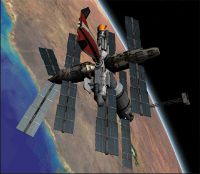Difference between revisions of "Mir"
Jump to navigation
Jump to search
m |
|||
| Line 1: | Line 1: | ||
| − | + | [[Image:Mir.jpg|200px|thumb|right|Mir]] | |
| + | In Orbiter, the Russian MIR station is still in orbit around Earth and can be used for docking | ||
| + | approaches. Furthermore, unlike its real-life counterpart, Orbiter’s MIR is orbiting in the plane | ||
| + | of the ecliptic, which makes it an ideal platform to launch lunar and interplanetary missions. | ||
| − | + | MIR sends a transponder (XPDR) signal at default frequency 132.10 which can be used for | |
| + | tracking the station during a rendezvous maneuver. | ||
| + | |||
| + | MIR supports 3 docking ports, with the following IDS transmitter frequencies: | ||
| + | * Port 1 135.00 | ||
| + | * Port 2 135.10 | ||
| + | * Port 3 135.20 | ||
| + | |||
| + | |||
| + | ==External Links== | ||
| + | [http://en.wikipedia.org/wiki/Mir Mir on Wikipedia] | ||
Revision as of 10:58, 10 April 2008
In Orbiter, the Russian MIR station is still in orbit around Earth and can be used for docking approaches. Furthermore, unlike its real-life counterpart, Orbiter’s MIR is orbiting in the plane of the ecliptic, which makes it an ideal platform to launch lunar and interplanetary missions.
MIR sends a transponder (XPDR) signal at default frequency 132.10 which can be used for tracking the station during a rendezvous maneuver.
MIR supports 3 docking ports, with the following IDS transmitter frequencies:
- Port 1 135.00
- Port 2 135.10
- Port 3 135.20
